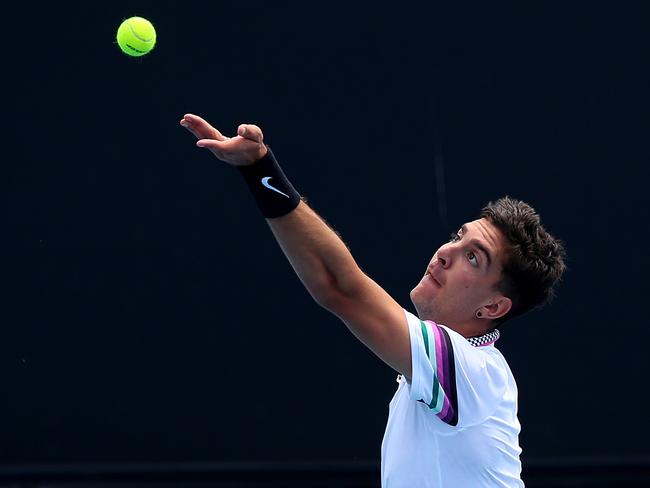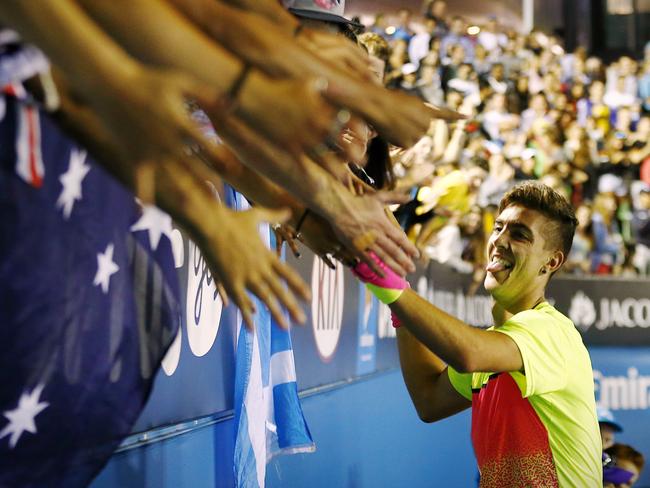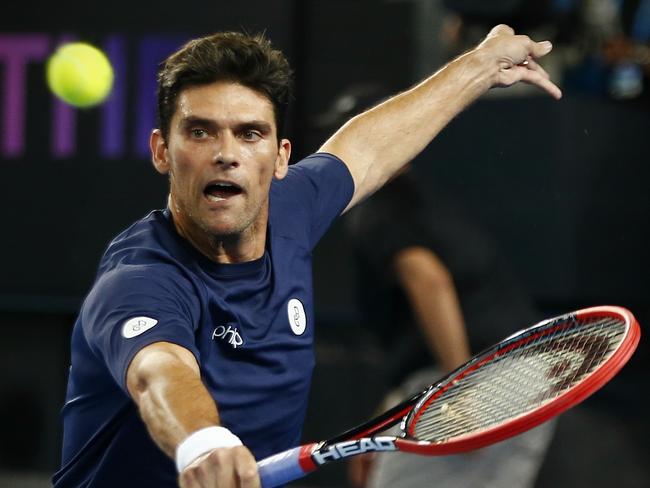Lead-in tournaments will restrict fan movement ahead of Australian Open
Melbourne Park will be packed full of competitive tennis before the Australian Open. But spectators will need to prioritise which matches they wish to see.
Tennis
Don't miss out on the headlines from Tennis. Followed categories will be added to My News.
Tennis fans will be zoned in three pockets of Melbourne Park for the Australian Open’s lead-in tournaments in a dress rehearsal for how the grand slam will operate.
The home of Australian tennis will be the scene of a smorgasbord of action even before the Open starts on February 8, with five ATP and WTA events scheduled for the week previous.
Those tournaments would typically be spread across the country rather than all being in Melbourne, but the dramatic COVID-19 circumstances led to a unique event structure in 2021.
Australian Open tournament director Craig Tiley said it was a priority to provide as many competitive opportunities for the players as possible.
“It’s been an incredibly difficult year for everyone, and the players have had limited opportunity to compete throughout 2020,” Tiley said.
“These additional events will be vital to their Australian Open preparation.”
Ticket-holders won’t be able to move between the zones on the same day, meaning they’ll have to be selective about what they want to watch once matches begin on January 31.

Rod Laver Arena will be exclusively used for the ATP Cup, which pits 12 top-tier tennis nations against one another, across four round-robin groups, between February 1 and 5.
Defending champion Serbia, Spain, Austria, Russia, Greece, Germany, Argentina, Italy, Japan, France, Canada and wildcard entrant Australia are expected to be the countries involved.
ATP Cup matches will also feature on Margaret Court Arena, while WTA 500 and ATP 250 events will be played on the western courts.
There will be 64-player singles and 32-player doubles draws at the non-ATP Cup tournaments, with organisers tipping strong fields.
Women’s tennis fans will want to buy tickets for the newly-named John Cain Arena (formerly Melbourne Arena) and Melbourne Park’s eastern courts, with only WTA matches being played there.
Another WTA 250 event is locked in for Melbourne Park during the second week of the Australian Open, starting on February 13.

Regional Victoria largely missed out on their piece of the pie, although Traralgon will host two all-Australian junior events.
There will also be two wheelchair tournaments at Hume Tennis Centre, from February 3-6 and 8-11, ahead of the Open.
The Australian Open’s qualifying events will be hosted overseas for the first time, in Doha and Dubai, between January 10 and 13.
Sixteen qualifiers and six alternates will then travel to Melbourne to enter a 14-day quarantine period.
Any player competing in the Open must enter quarantine by January 16 and return a negative coronavirus test 48 hours before flying to Australia as part of strict protocols.
Players will need to return another negative test on arrival before being able to practice from day two, and will be subjected to regular nasopharyngeal PCR tests, as well as PCR saliva tests, in quarantine.
Ticket release dates and crowd capacity for the lead-in events are still to be determined.
KOKKINAKIS EYES HEALTHY FUTURE AFTER PAIN
Thanasi Kokkinakis spent last New Year’s Eve – weeks out from the Australian Open – hooked up to a machine monitoring his breathing at Adelaide’s Flinders Medical Centre.
The injury-cursed, would-be tennis star was at rock bottom, which is saying something after his barely believable run of misfortune.
He’d been diagnosed with glandular fever and his throat was so swollen that his girlfriend at the time told him he was going extended periods without breathing while he slept.
That’s how Kokkinakis ended up in hospital, barely sleeping a wink. When he did nod off and subsequently stopped breathing, an alarm would sound and a nurse would burst in.
“It’s pretty bad to admit, but eventually I was like, ‘Surely I’m not going to die’,” Kokkinakis sheepishly told News Corp this week. “So I turned the monitor off for a bit to try and get some sleep, because I was driving myself insane.”

Instead of preparing for another Australian Open tilt, Kokkinakis underwent an operation – this time to remove his tonsils.
About 12-13kg were stripped from his six-foot-four frame in the following fortnight, because of his inability to eat much of anything.
The 24-year-old could only watch, as he has so often in the past five years, as his great mate Nick Kyrgios reached the last 16 at Melbourne Park for a third time.
They have taken different paths since Kyrgios, one year Kokkinakis’ senior, edged out his countryman in the highest-profile Australian Open boys’ final ever, almost eight years ago.
Kyrgios has reached a pair of grand slam quarter-finals and set a career-high ranking of No.13 – while probably still underachieving – whereas Kokkinakis has never been ranked better than 69th and currently sits at No.260.
There were genuine debates in their teenage years about who was the better prospect, because Kokkinakis’ ability and vast on-court weapons have never been in question.
His scalps include (most famously) Roger Federer, Milos Raonic, Tomas Berdych, Fabio Fognini, Lucas Pouille, Ernests Gulbis and Juan Monaco, all of whom peaked inside the top 10.

That five-set takedown of Gulbis in front of a raucous crowd in the first round at the 2015 Australian Open, aged 19 and impossible to miss in fluoro Nike gear, remains one of his dearest highlights.
However, Kokkinakis just hasn’t been able to stay healthy.
It was revealed in the wake of that Australian Open boys’ final that he played with a stress fracture in his back and faced a long period out. If only he knew how poetic that would be.
Since then, Kokkinakis’ ailments include the debilitating bout of glandular fever, a fractured kneecap, an abdominal strain, shoulder issues, osteitis pubis, multiple torn pectoral muscles and even an elbow-related setback.
The knee injury occurred in a freak accident where he crashed into advertising signage bordering the court in the Monte Carlo Masters two years ago.
At the start of 2018, Kokkinakis conceded his career-threatening right shoulder problem was the side-effect of lifting weights and his want for bigger ‘guns’ ahead of Nike’s release of sleeveless tops.
Then the groin flare-up came after he obsessively started running 12km a day while his upper body failed him.

“That’s sometimes what’s good about me, but also a negative thing about me,” he said. “I’m an extreme thinker, so if something’s really going to help me, I’ll just smash it until the cows come home.
“Sometimes it has a positive effect, but other times it has a negative effect. Obviously, I haven’t quite got the balance right.”
The one positive of the COVID-19-ravaged 2020 tennis season was there was no temptation for Kokkinakis to rush back before he was ready.
In fact, he even chose not to head to Europe for the postponed French Open, realising it wasn’t the best move for him.
What the talent-rich South Australian did instead was spend seven months training in Melbourne with his peers, as well as megastars of yesteryear Lleyton Hewitt and Mark Philippoussis.
Hewitt is one of Tennis Australia’s most influential figures, but Philippoussis – a Greek-Australian, like Kokkinakis and Kyrgios – largely keeps away, outside of appearances on the ATP Champions Tour.
Philippoussis has always made himself available to Kokkinakis, who he speaks extensively, caringly and glowingly about.

“He works hard, he’s got a good head on his shoulders, he’s actually interested in listening and he’s grateful I’m on the court with him,” Philippoussis said.
“I’ve got all the time in the world for someone like that.
“He’s still young and there’s no need to panic, but what he’s got to understand is, ‘Look, I’m not a rookie anymore. I’m 24, I know where I’ve got to be and what’s needed of me’.
“I think he’s starting to understand that and there’s starting to be some urgency about him as a player and an athlete.”
For Kokkinakis’ part, he describes his horror run of recent seasons as “pretty frustrating and depressing”. Yet the belief he’s always had, plus the evidence of his ability on court, is what keeps him going.
“If I was coming back and losing to everyone, I’d be like, ‘Why am I doing this?’,” Kokkinakis said. “But when I’ve come back, I’ve actually been competitive and beaten some good guys.
“That gives me the thought process of, ‘Hang on, if I can stay healthy for a long period of time, I’ve actually got a chance to do something pretty good here’.”
THANASI KOKKINAKIS’ AUSTRALIAN OPEN TIMELINE
2013: Lost boys’ final to Nick Kyrgios. Revealed afterwards he was playing with a back stress fracture.
2014: Won on his men’s main draw debut before bowing out to Rafael Nadal.
2015: Beat Ernests Gulbis in five sets, then lost a five-setter to Sam Groth.
2016: DNP. Recovering from right shoulder surgery.
2017: DNP. Withdrew on tournament eve because of an abdominal strain.
2018: Lost in round one to Daniil Medvedev. Had treatment on his calf and shoulder mid-match, then found out afterwards he’d also strained a pectoral muscle.
2019: Qualified for the main draw despite a worsening pectoral tear, then retired while a set up on Japan’s Taro Daniel because of the injury.
2020: DNP. Recovering from glandular fever.
2021: Received a main draw wildcard.
More Coverage
Originally published as Lead-in tournaments will restrict fan movement ahead of Australian Open




